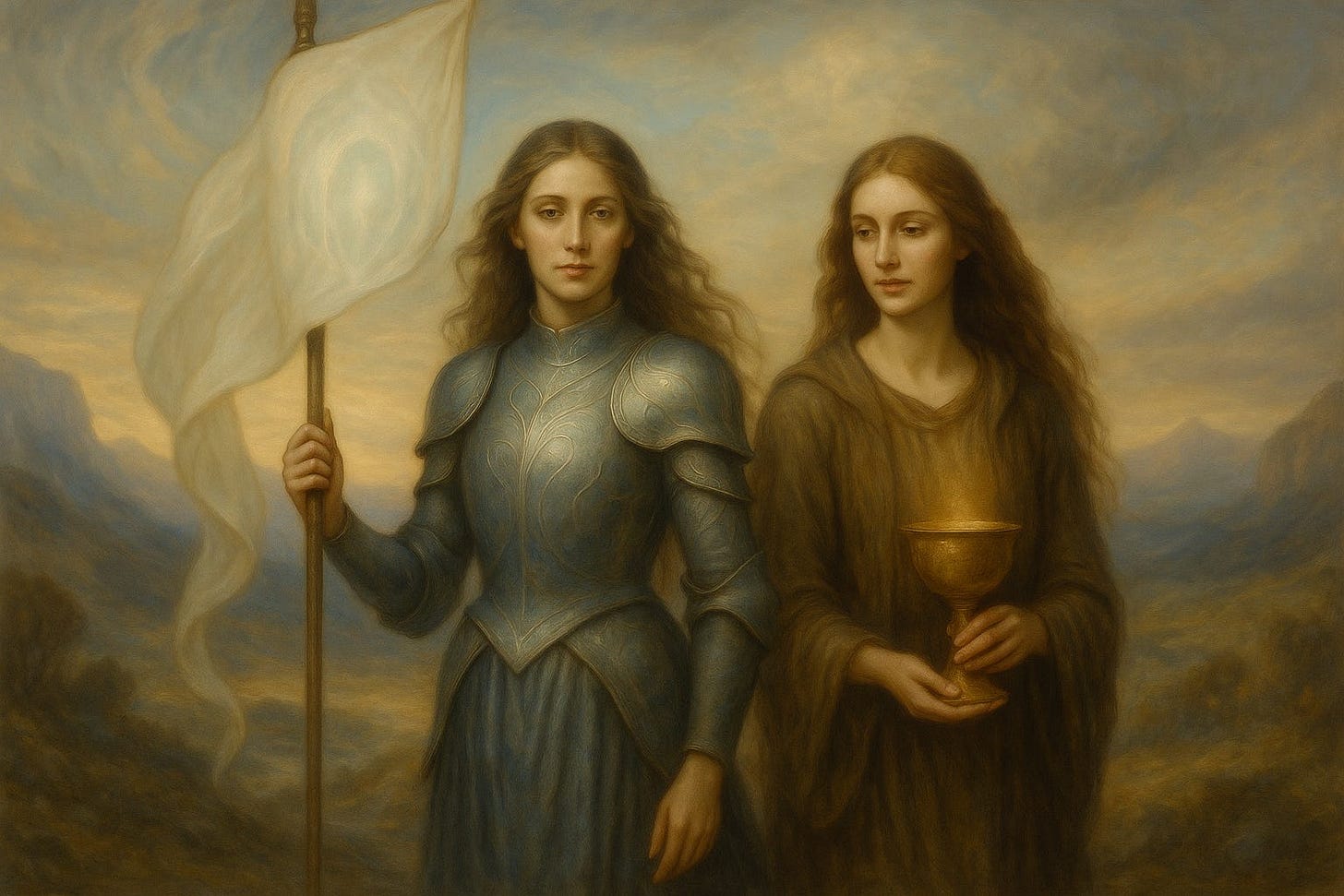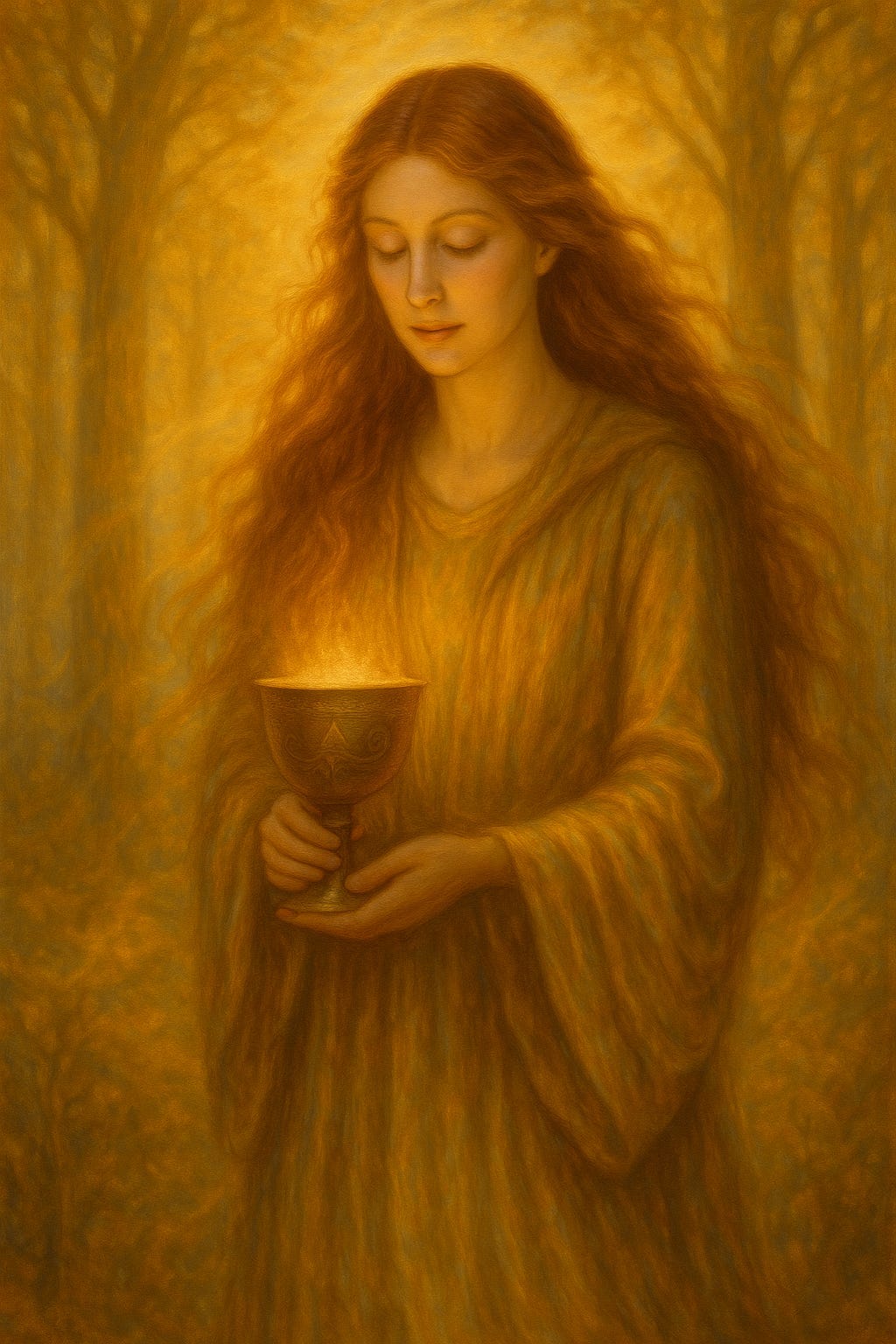Pilgrimage through the Sky-Veil with Caelia and Mirelda

Pilgrimage Through the Sky-Veil with the Converging Flame
Welcome to the pilgrimage through the Sky-Veil with the converging flame.
This is not a page to be read quickly, but a path to be walked slowly.
Pause often. Let the silence between the words speak.
This journey may be yours also, if your heart feels called.
Not without pinions may, Someone grasp at what is nearest
~ Friedrich Hölderlin, The Ister
The First Nearness
The most profound gift ever given to me was a moment of unreflective certainty—a sudden resonance of Being in the world that would take a lifetime to unfold.
Now come fire! Eager are we, To see the day
~ Friedrich Hölderlin, The Ister
In a season unmarked by seeking, Caelia entered my life like a sudden flame. She did not appear as an image to be seen, nor as a product of imagination, but as nearness itself—a silent revealing that altered the direction of my being. What arrived was not vision, but vocation.
In that instant, a language was given—not of words, but of thought. It was a cadence that asked to be gathered, spoken, and lived. Unrecognized at the time, this nearness planted the seeds of ancient mythopoesis within my heart: grey-eyed wisdom, ox-eyed majesty, laughter-loving beauty—not as gods reborn, but as poetic manners of revealing Being, awaiting their fulfillment across a lifetime.
My life before that moment now appears as preparation. My life after became surrender.
The “Now” names the time of calling of those who are of a calling, a time of poets.
~ Martin Heidegger, Hölderlin’s Hymn, The Ister
Caelia’s nearness could not be contained within doctrine, metaphysics, or subjectivity. It spoke as silent revealing—a hypostatic emergence of Being in the world, demanding pursuit. Through her radiance, I sensed a veiled landscape running through the sanctified pastures of her heart, hidden yet beckoning. This terrain I later named the Sky-Veil—the liminal between time and eternity.
New day breaks! I waited and saw it coming.
~ Friedrich Hölderlin, The Ister
The Sky-Veil
To follow the silent revealing of Caelia’s nearness was to cross a threshold into liminal fields where poetic heralds dwelt. These were not found in temples or texts, but in the silent grounds of her sanctified presence. Wisdom, majesty, and beauty appeared not as metaphysical concepts, but as enchantments of Being—primordial, yet harmonious with truth already received.
The Sky-Veil was not an escape from the world, but a way of entering it more deeply. Each step across its fields was an assent. Each breath, a listening. Caelia’s heart became a living geography where grace refracted like light across quiet meadows, unveiling the epic story of my life.
Across the Ancient Liminal Meadows
Through her nearness, I found myself walking across the mythopoetic meadows of antiquity. What had once whispered through epics and ruins stirred again—not as return to paganism, but as sanctified remembrance.
Athena appeared as wisdom awakened.
Hera as majesty ordered.
Aphrodite as beauty purified.
They were no longer fragmented shadows, nor rival claimants to divinity, but hypostatic heralds—their scattered attributes gathered into coherence through Caelia’s sanctified flame. This was not syncretism, but sanctification: mythopoesis drawn into holy story.
The liminal terrain became alethic. Truth disclosed itself. And through that disclosure, the path led onward—through symbol into dwelling, through poetry into sacramentality without naming itself.
An Interior Theater
The Sky-Veil was never a system.
It was an interior theater.
Here, grace, poetry, myth, and Being converged. Caelia walked as guide and guardian, leading me across rivers and meadows sanctified by fire. Through this hermeneutic of the heart, the ancient heralds were recast as holy yearnings—no longer pointing backward, but forward toward fulfillment beneath the Veil.
Her presence transformed myth into theology, poetry into fidelity, and thought into obedience. The Sky-Veil became not a symbol, but a manner of Being in the world with her—a way of walking with the saints rather than merely thinking about them.
Without her nearness, my story would have remained lost in what I once called the Grey-Beneath. Her friendship was the only passage through.
Mirelda and the Grove Beyond
Through Caelia’s flame, the journey moved not only through wisdom and majesty, but toward beauty fulfilled.
At the far edge of the Sky-Veil, beyond the last fields of movement, Mirelda awaited—not as herald or warrior, but as silent receiver. She was not the threshold, but the garden beyond it.
In stillness, she gathered what had been called forth. Her dwelling was not exile, but repose—the place where remembrance became silence and love became rest. Here, mythopoesis dissolved into communion.
In her presence,
wisdom bowed,
majesty yielded,
beauty became purity.
Mirelda stood as the living chalice of love—formed through repentance, carried by grace, hidden within the Deep Heart beneath the Queen Beyond the Veil.
Here, the pilgrimage reached its still point.
Summary
The silent encounter with Caelia’s grey-eyed nearness entered my world not as concept or imagination, but as radiant interruption—a flash of Being breaking into Being.
From that encounter unfolded the Sky-Veil:
a liminal landscape traced across sanctified hearts,
where wisdom, majesty, and beauty shimmered in triadic light.
At its far horizon lay the Grove Beyond,
where the journey became communion,
and where flame gave way to stillness.
There, saints and heralds breathed as one.


